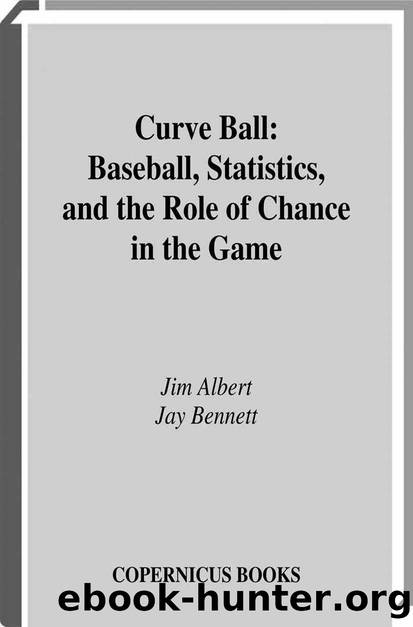Curve Ball by Jim Albert & Jay Bennett

Author:Jim Albert & Jay Bennett
Language: eng
Format: epub
Publisher: Springer-Verlag New York, Inc. 2001
Published: 2015-02-18T16:00:00+00:00
Using Table 7-6 (or Table 7-5), we can calculate the average value of a home run. This is done by simply multiplying its value in each situation by the percentage of times the situation occurs, then summing over all situations:
What does this value represent? Certainly we have seen that in Lindseyâs model, some HRs are worth less than 1.42 runs while others are worth more. But on average, for a large sample of situations, Lindsey found that in 1959â1960, a good estimate of the value of a home run was 1.42 runs.
The next question, naturally, is what about the average run values for other plays? Lindsey performed calculations following the same procedure for singles, doubles, and triples. For now, we will just summarize our own numbers, based on Lindseyâs calculations, in Table 7-7.9 On average, the difference between the most and least valuable hits is less than one run. More intriguing are the run value ratios which indicate that a HR is on average about three times as productive as a single. For the sake of comparison, the rightmost column presents the relative values of these hits in terms of bases. We see that a base interpretation of value appears to overestimate the run value of extra-base hits. Besides the home run, a triple is worth less than three times the runs of a single, and a double is worth less than twice the runs of a single. Table 7-7 Average Values of Hits with Respect to Runs and Bases
Download
This site does not store any files on its server. We only index and link to content provided by other sites. Please contact the content providers to delete copyright contents if any and email us, we'll remove relevant links or contents immediately.
Tip Top by Bill James(1291)
Three-Ring Circus by Jeff Pearlman(802)
1312, Among the Ultras by James Montague(717)
One Life by Megan Rapinoe & Emma Brockes(649)
Like Streams to the Ocean by Jedidiah Jenkins(600)
Don Cherry's Hockey Stories and Stuff by Don Cherry(597)
The Dynasty by Jeff Benedict(597)
Maradona: The Boy. The Rebel. The God. by Guillem Balagué(565)
Crossroads by Kaleb Dahlgren(551)
Bruce Lee by John Little(538)
The Greatest Game Ever Played by Mark Frost(524)
On Learning Golf by Percy Boomer(498)
The Tai Chi Space: How to Move in Tai Chi and Qi Gong (A Pictorial Guide) by Paul Cavel(446)
Bravey by Alexi Pappas(442)
My Life in Red and White by Arsene Wenger(441)
The Pocket Samurai by William Scott Wilson(438)
Breathe by Rickson Gracie(434)
Powerbuilding Breakdowns by Josh Bryant & Adam benShea(408)
Running Back in Time: Discovering the Formula to Beat the Aging Process and Get Younger (Younger Than Ever Book 2) by Gilkis Dr. Zeev(399)
